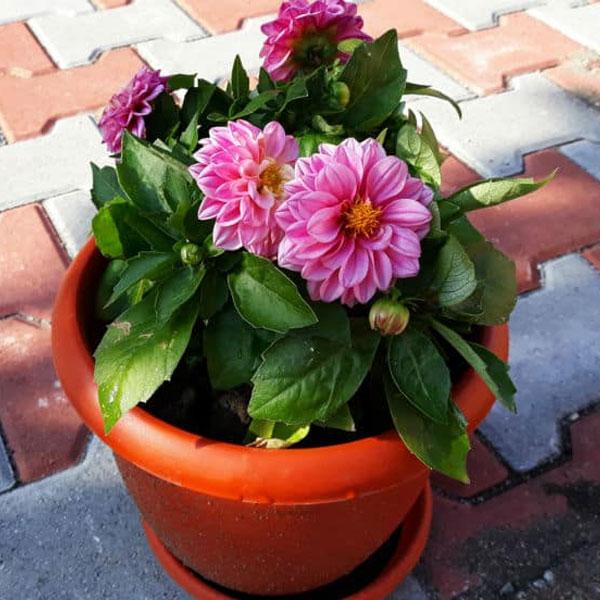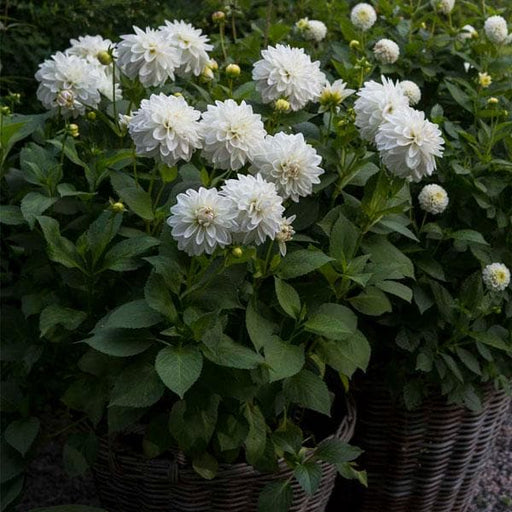Dahlia Plant Care
Dahlia plants are beautiful and vibrant, but they require some care to keep them healthy and thriving. Proper care includes planting them in a sunny location with well-drained soil, watering them regularly, and fertilizing them every few weeks. It's also important to deadhead spent flowers and to remove any diseased or damaged foliage. With the right care, Dahlia plants can provide years of beauty in your garden.
Dahlia Bulbs
Dahlia bulbs are the underground storage structures that provide energy and nutrients to the plant. They are typically planted in the spring and can produce beautiful blooms throughout the summer and fall. When planting Dahlia bulbs, it's important to choose a location with well-drained soil and to plant them at the right depth. It's also important to protect the bulbs from freezing temperatures in the winter.
Dahlia Varieties
There are hundreds of Dahlia varieties, ranging from small pom-pom blooms to large dinner-plate-sized flowers. Some popular Dahlia varieties include the 'Bishop of Llandaff,' 'Cafe au Lait,' and 'Karma Choc.' Each variety has its own unique characteristics and growing requirements, so it's important to research and choose the right Dahlia for your garden.
Dahlia Colors
Dahlia plants come in a wide range of colors, including white, yellow, orange, pink, red, and purple. Some varieties even have bi-colored or striped blooms. When choosing Dahlia plants for your garden, consider the color scheme and choose blooms that will complement or contrast with other plants in the area.
Dahlia Pests
Dahlia plants can be susceptible to pests, including aphids, spider mites, and slugs. To prevent pests, it's important to keep the area around the plants clean and free of debris. If pests do appear, there are organic and chemical pest control options available to help protect your plants.
Dahlia Diseases
Dahlia plants can also be vulnerable to diseases such as powdery mildew, leaf spot, and root rot. To prevent diseases, it's important to plant Dahlia plants in well-drained soil and to provide good air circulation around the plants. If diseases do appear, there are fungicides and other treatments available to help protect your plants.
Dahlia Companion Plants
Dahlia plants can be grown with a variety of other plants to create a beautiful and diverse garden. Some popular companion plants for Dahlia plants include zinnias, cosmos, and sunflowers. When choosing companion plants, consider the height, color, and growing requirements of each plant to ensure they will complement each other.
Dahlia Propagation
Dahlia plants can be propagated through division, cuttings, or seeds. Division involves separating the plant into smaller sections and planting each section separately. Cuttings involve taking a stem cutting from the plant and rooting it in water or soil. Seeds can be harvested from the plant and planted in the spring.
Dahlia Arrangements
Dahlia blooms make beautiful cut flowers and can be used in a variety of floral arrangements. They can be paired with other flowers such as roses, hydrangeas, and peonies to create stunning bouquets and centerpieces.
Dahlia Symbolism
In Victorian times, Dahlia flowers were often associated with betrayal and dishonesty. However, in modern times, they are more commonly associated with elegance, dignity, and commitment. Dahlia flowers are often given as gifts for birthdays, anniversaries, and other special occasions to symbolize lasting love and commitment.
Dahlia History
Dahlia plants are native to Mexico and were introduced to Europe in the 18th century. They were named after Swedish botanist Anders Dahl, who was a student of Carl Linnaeus. Dahlia plants became popular in Europe in the 19th century and were brought to the United States in the mid-1800s.
Dahlia Exhibition
Dahlia plants are often grown and exhibited in competitions and exhibitions. These events showcase the best and most beautiful Dahlia blooms and attract enthusiasts and growers from around the world.
Dahlia Garden Design
Dahlia plants can be used in a variety of garden designs, from formal to cottage-style gardens. They can be planted in borders, raised beds, and containers to create a vibrant and colorful display.
Dahlia Photography
Dahlia plants make great subjects for photography, with their bright colors and intricate blooms. They can be photographed in a variety of settings, from gardens and parks to floral arrangements and still life setups.
Dahlia Crafts
Dahlia blooms can be used in a variety of crafts, including wreaths, garlands, and floral arrangements. They can also be dried and used in potpourri or as decorations in home decor.
Dahlia Wedding Flowers
Dahlia blooms are a popular choice for wedding flowers, with their vibrant colors and elegant blooms. They can be used in bridal bouquets, centerpieces, and other floral arrangements to add a touch of beauty and elegance to the special day.
Dahlia Festivals
Dahlia festivals are held in many parts of the world, showcasing the beauty and diversity of Dahlia plants. These events often feature flower shows, garden tours, and other activities celebrating the beauty and importance of these stunning plants.
Dahlia Medicinal Uses
Dahlia plants have been used for medicinal purposes in traditional medicine. The leaves and tubers of the plant contain compounds that have been used to treat a variety of ailments, including digestive issues and skin conditions.
Dahlia Art
Dahlia plants have been the subject of many works of art, including paintings, sculptures, and photographs. They are often depicted in still life paintings and floral arrangements, and their vibrant colors and intricate blooms make them a popular subject for artists of all kinds.
Dahlia Symbolism in Literature
Dahlia flowers have been referenced in literature, including in the works of Pablo Neruda, Federico García Lorca, and Sylvia Plath. In literature, they are often used to symbolize beauty, love, and passion.













































